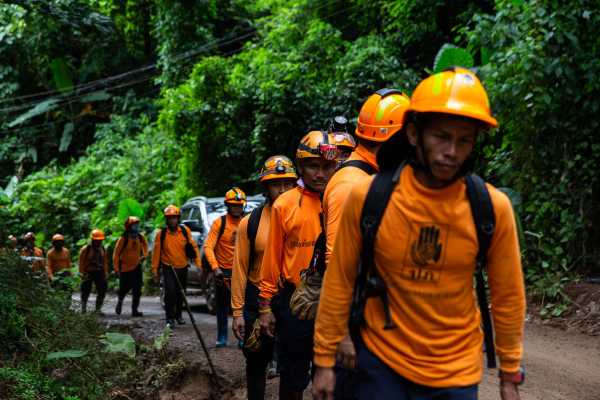
For the 12 Thai boys and their coach trapped in a cave by floodwaters, the biggest threat now is time.
The soccer team, which had been missing for nine days, was found this past Monday by British divers. The floods that trapped them nearly 3 miles from the mouth of the cave are also making a possible escape treacherous.
Currently, it’s taking rescue divers more than five hours to reach the boys, and one, a former Thai Navy Seal, died amid the support and rescue operations. Despite a vigorous effort to dig holes to reach to boys from above and pump the cave dry, officials worry if it keeps raining, it could be four months before the caves are dry enough to allow the kids to walk out.
But the kids and their coach may not have four months. As the New York Times reports, oxygen is starting run out in the alcove where they are located. “The oxygen level in the boys’ cavern is about 15 percent and decreasing,” the Times reports.
The air you and I are comfortably breathing contains around 21 percent oxygen. Dipping below 16 percent is like the equivalent of climbing a tall mountain.
“The problem is that oxygen is the major thing our body uses as fuel,” says Arun Chopra, director of pediatric critical care at Hassenfeld Children’s Hospital at NYU Langone. He’s not involved in the disaster response, but routinely sees young patients who have been put in dire circumstances.
When oxygen runs low, he explains, it affects our ability to think clearly and physical exertion becomes much more taxing. “They’re going to be less tolerant of any kind of stress you put them under, whether that’s inadequate food sources, or if they had to exercise, or think critically.”
The oxygen in the cave is depleted because the area where the kids are trapped does not seem to be receiving much ventilation from the surface. Which means every breath they breathe in, and every breath their rescuers breathe in, strips a tiny about of oxygen from their environment. And every exhalation also increases the amount of carbon dioxide in the environment, which too, over some time, can make it harder to breathe.
In the short-term, he says, the risk is that “their ability to think will be radically compromised.” Which is scary, considering how they may have to embark on a dangerous and technically challenging escape. They might even have to learn how to dive through the caves themselves.
Rescue workers are currently trying to run an oxygen line from the mouth of the cave to the chamber that the kids are trapped in to solve this problem. But the task is made all-the-more difficult by the fact that the waters are murky, and some of the sections of the cave require tight underwater maneuvers. Remember: it takes five or more hours for rescuers to traverse the nearly 3 miles from the mouth of the cave to the chamber.
Time is running out, and local rescue officials are feeling the pressure, saying, according to a Thai news source, there’s a “limited amount of time” to get them out.
If the oxygen in the cave continues to decrease, the prognosis for the boys isn’t good.
The dangers of losing oxygen, explained
The US Occupational Safety and Health Administration considers environments with less than a 19.5 percent oxygen by volume to be oxygen-deficient, and a health hazard.
“At concentrations of 16 to 19.5 percent,” OSHA explains, “workers engaged in any form of exertion can rapidly become symptomatic as their tissues fail to obtain the oxygen necessary to function properly.” And symptoms of oxygen deprivation include impaired thinking, loss of coordination, as well as increased stress on the heart and lungs as they try to pump what oxygen remains to the body’s organs.
The symptoms of being deprived of oxygen can mimic being drunk, Chopra explains. “Which isn’t safe in the confined spaces of a cave.” When oxygen levels dip between 12 and 16 percent, breathing and heart rates continue to increase. Attention and coordination are diminished even in people who are resting.
If the oxygen levels remain at around 15 percent, NYU’s Chopra says, then the boys might be able to adapt. Their bodies will produce more hemoglobin — the molecule in blood to which oxygen binds — and more oxygen will be carried to their brains and bodies. At these levels, he says, the boys will likely quickly recover when exposed to higher levels of oxygen.
But if the levels dip further, things get scarier. “The numbers 15 or 16 percent that we’re talking about is right at the tipping point,” Chopra says. Beyond that even minimal exertion can lead to difficulty in breathing and immediate exhaustion. You start to starve the heart and brain of oxygen, which can lead to long-term injury.
Below 10 percent oxygen “nausea, vomiting, lethargic movements, and perhaps unconsciousness” can occur, OSHA reminds. Less than 6 percent? That “produces convulsions, then apnea (cessation of breathing), followed by cardiac standstill.” Death might not come long after.
Beyond the boys’ physical health, Chopra says we should also worry about their mental health, which also might be worsened in a low-oxygen environment.
“Probably the biggest problems these kids are going to have is dealing with the isolation, and psychological stress of being trapped in a small space for a prolonged period of time,” he says. “And all of that is going to be exacerbated by not having enough oxygen, which can lead to erratic behavior that is potentially dangerous.”
Sourse: breakingnews.ie
0.00 (0%) 0 votes


































